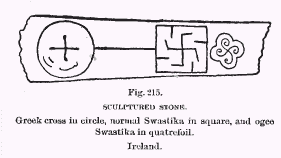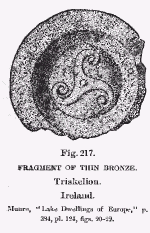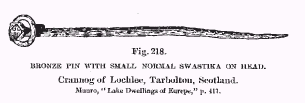

Dispersion of the Swastika
the subject. But on the
upper part of one of its faces appears an inscription, boldly and deeply
incised, of forty-four characters arranged horizontally in six lines.
 These
are of so remarkable a type as to have puzzled every philologist and paleographer
who has attempted their decipherment. The late Alexander Thomson, esq.,
of Banchory, Scotland, circulated a photograph and description of this
monument among antiquarians with a request for their decipherment of it.
Various readings have been given by the learned gentlemen, who have reported
it to be Hebrew, Phenician, Greek, Latin, Aryan, Irish, and Anglo-Saxon
respectively. Brash (1) gives
his opinion that the inscription is in debased Roman letters of a type
frequently found in ancient inscriptions, its peculiarities being much
influenced by the hardness of the stone at the time of cutting and the
subsequent
These
are of so remarkable a type as to have puzzled every philologist and paleographer
who has attempted their decipherment. The late Alexander Thomson, esq.,
of Banchory, Scotland, circulated a photograph and description of this
monument among antiquarians with a request for their decipherment of it.
Various readings have been given by the learned gentlemen, who have reported
it to be Hebrew, Phenician, Greek, Latin, Aryan, Irish, and Anglo-Saxon
respectively. Brash (1) gives
his opinion that the inscription is in debased Roman letters of a type
frequently found in ancient inscriptions, its peculiarities being much
influenced by the hardness of the stone at the time of cutting and the
subsequent  weather
wear of ages. The interest of this monument to us is that the third character
in the fourth line is a Swastika. It is indifferently made, the lines
do not cross at right angles, two of the ends are curved, and the two
others bent at a wider than right angle. There are four characters in
the line closely following each other. (See. p. 797.)
weather
wear of ages. The interest of this monument to us is that the third character
in the fourth line is a Swastika. It is indifferently made, the lines
do not cross at right angles, two of the ends are curved, and the two
others bent at a wider than right angle. There are four characters in
the line closely following each other. (See. p. 797.)
The Logic stone, in Aberdeenshire,
Scotland, bearing Ogam characters, contains a figure or mark reported
by George M. Atkinson as a Swastika. (2)
On the Celtic crosses of Scotland
certain marks appear which are elsewhere found associated with Swastika,
and consequently have some relation therewith. The "Annam Stone:
bears the mark of a Swastika (left) within three concentric circles, around
the outside of which is a circle of dots. (3)
Ludwig Müller reports the Swastika
in Scotland and Ireland on Christian tombs, associated with Latin crosses.
(4)
A sculptured stone in Ireland (fig.
215) shows on the face three varieties of the  cross,
a Greek cross in a circle, a Swastika with square ends turned to the right,
within a rectangle, and a ogee (tetraskelion) turned to the right, enclosed
in a quatrefoil. (5)
cross,
a Greek cross in a circle, a Swastika with square ends turned to the right,
within a rectangle, and a ogee (tetraskelion) turned to the right, enclosed
in a quatrefoil. (5)
An Irish bowl showed a Swastika thus ![]() .
Dr. R. Munro (6) reports from
the Crannog of Lesnacroghera country, Antrim, Ireland, two pieces or disks
of thin bronze, repoussés (fig. 216), bearing the sign of the Swastika
and having the four arms of the spirals turned to the left. The similarity
of this figure with those shown on the shields of the Pima Indians of
New Mexico and Arizona (figs. 257
and 258) is to be remarked.
Fig. 217 shows a triskelion of symmetric spirals turned to the right.
In the crannog of Lochlee, near Tarbolton, a bronze pin was found (fig.
218), the head of which was enclosed in a ring. On one side of the head
was engraved a Greek Cross, on the other was a normal Swastika turned
to the right. The same Crannog furnished a piece of ash wood five inches
square, which had been preserved, as were all the other objects, by the
peat, on which was carved a triskelion (fig.
219) after the form and style of those on the Missouri mound pottery.
.
Dr. R. Munro (6) reports from
the Crannog of Lesnacroghera country, Antrim, Ireland, two pieces or disks
of thin bronze, repoussés (fig. 216), bearing the sign of the Swastika
and having the four arms of the spirals turned to the left. The similarity
of this figure with those shown on the shields of the Pima Indians of
New Mexico and Arizona (figs. 257
and 258) is to be remarked.
Fig. 217 shows a triskelion of symmetric spirals turned to the right.
In the crannog of Lochlee, near Tarbolton, a bronze pin was found (fig.
218), the head of which was enclosed in a ring. On one side of the head
was engraved a Greek Cross, on the other was a normal Swastika turned
to the right. The same Crannog furnished a piece of ash wood five inches
square, which had been preserved, as were all the other objects, by the
peat, on which was carved a triskelion (fig.
219) after the form and style of those on the Missouri mound pottery.
Gallo Roman Period.
France.
--- The employment of the Swastika in France did not cease with the  Bronze
or Iron ages, but continued into the occupation of Gaul by the Romans.
Bronze
or Iron ages, but continued into the occupation of Gaul by the Romans.
Fig.
220 represents a stone altar erected in the south of France among
the Pyrenees about the time of the advent of the Romans. It has a Swastika
engraved on its pedestal. The upper arm has been carried beyond the body
of the sign, whether by intention is not
1. "Ogam Inscribed Monuments," p. 359, pl. xlix. [Back]
2. Ibid., p. 358, pl. xlviii. Back
3. Greg, Archæologia, XLVIII, pt. 2, pl. 19, fig. 27. Back
4. "La Migration des Symboles," p. 49. Back
5. Zmigrodzki "Zur Geschichte der Suastika," taf. 6, fig. 248. Back
6. "Lake Dwellings of Europe,: p. 384, pl. 124, figs. 20-22. Back
<< Previous Page Next Page >>
© 2004-2007 Northvegr.
Most of the material on this site is in the public domain. However, many people have worked very hard to bring these texts to you so if you do use the work, we would appreciate it if you could give credit to both the Northvegr site and to the individuals who worked to bring you these texts. A small number of texts are copyrighted and cannot be used without the author's permission. Any text that is copyrighted will have a clear notation of such on the main index page for that text. Inquiries can be sent to info@northvegr.org. Northvegr™ and the Northvegr symbol are trademarks and service marks of the Northvegr Foundation.

|